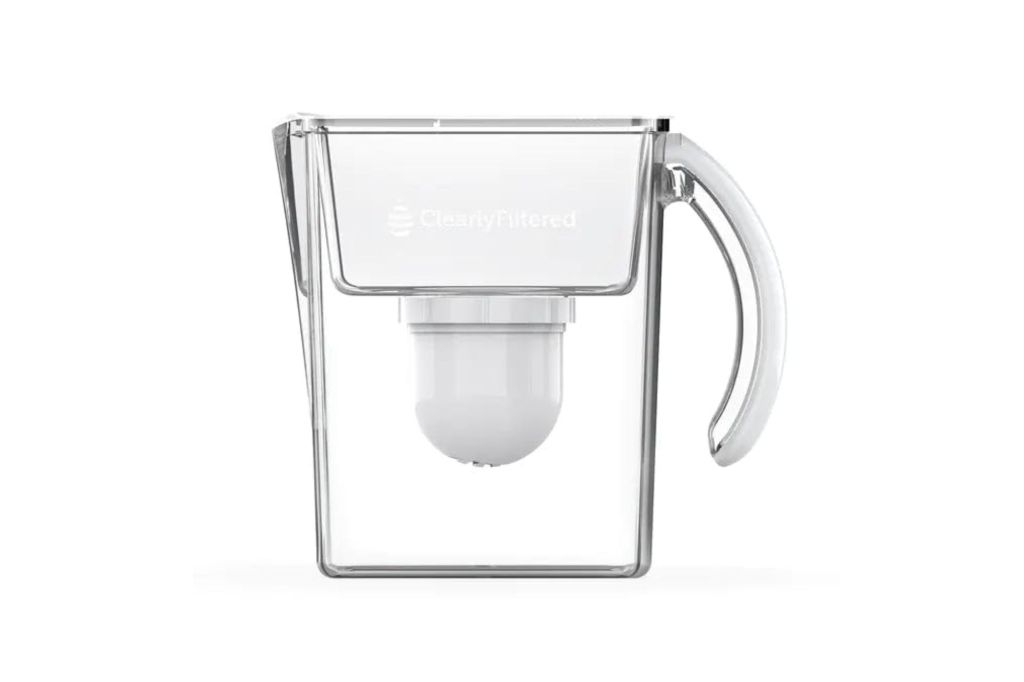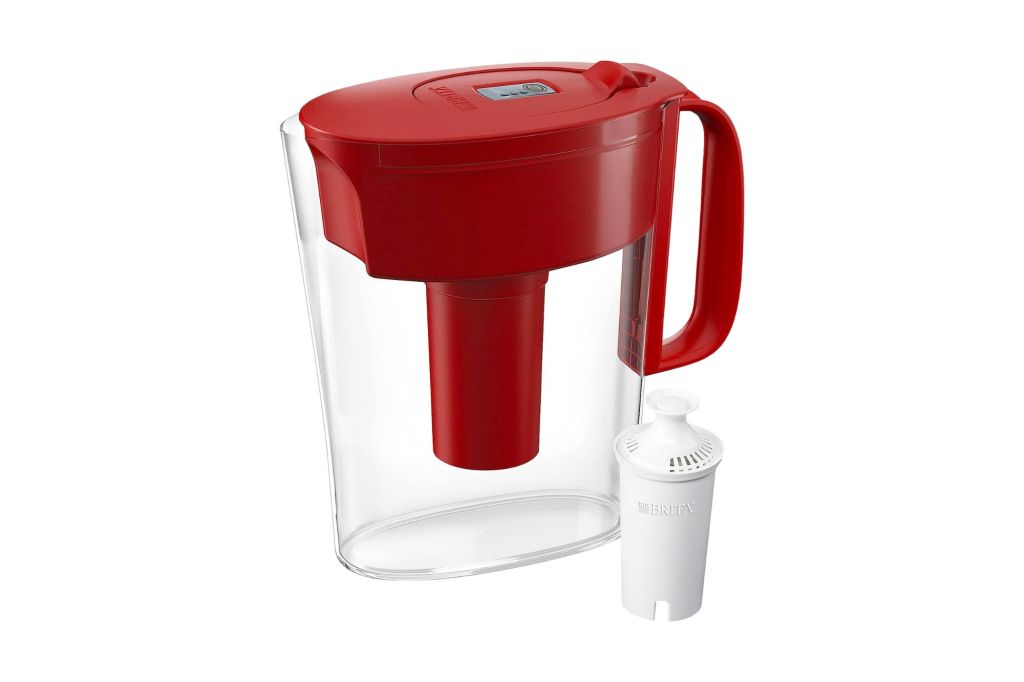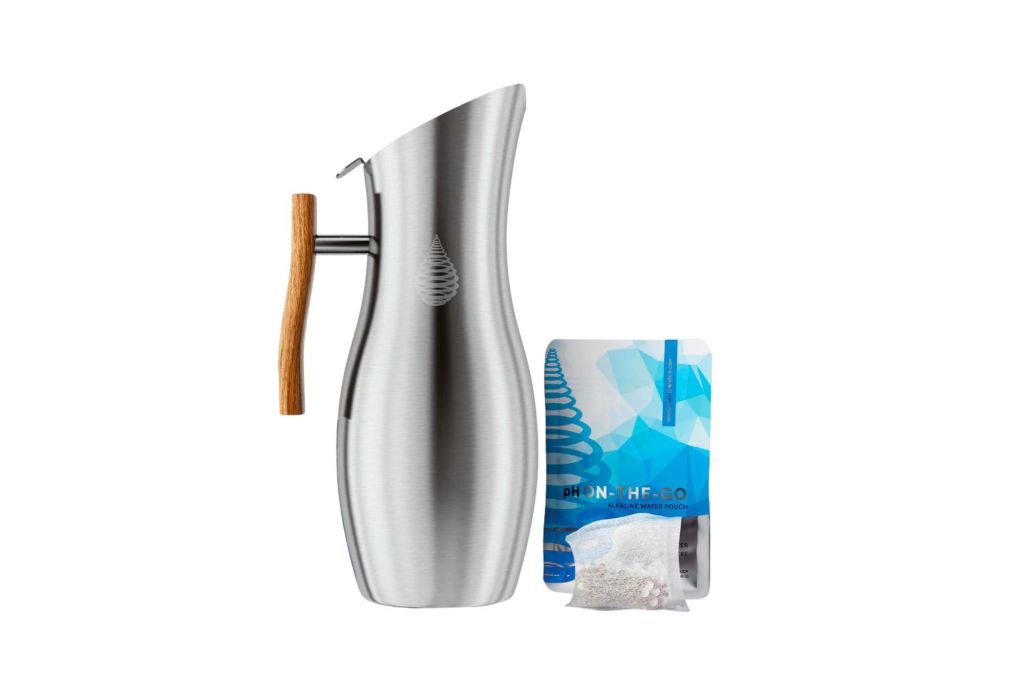When it comes to living a healthy lifestyle (or just living at all), drinking water is at the forefront.
While many United States citizens have access to water faucets, the number of can make it nearly undrinkable. Thankfully, we have water filter pitchers and filtration systems to save the day.
Although many different brands of water filters, such as or , they’re not all created equal. In an effort to give you the cleanest water possible and products that actually work, the New York Post spoke to Brian Campbell, water treatment expert and the founder and “lead water geek” at . Read our FAQ with him to learn the ins and outs of choosing the best water filter pitcher, how to test your water quality, the health benefits of filtering water and more.
It’s important to consider the type of filter used to reduce impurities that impact taste and cleanliness of water, the specific water impurities in your area, the size capacity that’s best for you and what materials make up the pitcher.
- Best Overall:
- Best Budget:
- Best for PFAS:
- Best Alkaline Making:
- Best BPA Free:
RELATED: Here’s what you can do about PFAS in your drinking water
The best water filter pitchers, according to an expert:
Best Overall:

Pros:
- Filters without removing trace minerals
- Made of BPA-free plastic
- Removes microplastics, benzene and other contaminants
Cons:
- Pitcher is not shatter or chip-proof
“With a larger filtered water holding capacity than a pitcher, this dispenser is capable of removing fluoride as well as 199 other contaminants commonly found in city water,” said Campbell, who specifically loves this option because it’s designed to fit nicely in most refrigerators.
Best Budget:

Pros:
- Fast filtration
- Lock fit design that keeps unfiltered water from mixing with filtered
- Reduces chlorine, recognizably changing taste
Cons:
- Lid tends to slide off
“The PUR pitcher holds an official NSF certification for standards NSF 42, 53 and 401. Although the filter doesn’t last as long as some others (only 40 gallons), this pitcher is a great budget option that will remove lead and 19 other city water contaminants,” Campbell said.
Best for PFAS:

Pros:
- Doesn’t give water a strange aftertaste
- Removes and reduces 200 contaminants, including PFAS
- Filter shell made of silver-infused ceramic
Cons:
- Pitcher’s filter time is on the slower side
Campbell recommends the Propur pitcher for those who don’t want to replace the cartridge too often.
“Coming in with a massive filter capacity of 225 gallons, you won’t have to worry about replacing the cartridges nearly as often,” he said. “The ProOne pitcher provides strong contaminant reduction [and is] capable of getting rid of 200 plus impurities.”
Best Alkaline Making:

Pros:
- Anti-slip base
- Pitcher is made from BPA-free, food-grade plastic
Cons:
- Filter has to be changed every 100 gallons
- Some customers complain about top leaking
“The pH Restore pitcher will remove aesthetic contaminants, improving the taste and smell of your water while at the same time increasing its pH by up to 2.0,” Campbell said. “Alkaline water [will] taste better and may provide additional health benefits.”
Editor-Approved Picks:
Best Third Party Tested:

Pros:
- Removes more than 300 contaminants from water
- Tested to meet NSF/ANSI standards 42, 53, 401 and 473
- Made with BPA-free, non-leaching plastic
Cons:
- Top pops off easily
Fluoride, lead, arsenic — scared of your water yet? Fortunately, this filter pitcher removes 365 plus contaminants, including microplastics and other things you don’t want to swallow. The container is non-leaching, small enough to easily fit inside the fridge, and has a lovely, minimalist design. Although you’ll only get 100 gallons of purified water before you have to replace the filter, we’ll overlook it for a yuck-free drink of agua.
Best BPA Free:

Pros:
- Lockable lid
- Easy to change filter
- Electronic filter change indicator
Cons:
- On the smaller side, which means you have to fill more if you drink a lot of water
This water filter pitcher from Brita has almost a perfect rating on Amazon. Its slim build makes it a cinch to store in an already-packed fridge, and its filtration system is designed to reduce the number of harmful impurities by up to 99%.
Best for TDS:

Pros:
- IAPMO certified
- Five-stage filtration system
Cons:
- Particles from filter can be seen floating at top when the pitcher is over-poured
What makes this water filter pitcher from Zerowater special is that it has a five-stage filtration system to remove salts, metals and minerals. It also comes with a TDS Meter to check the levels of contaminants before and after you filter. Tip: When it reads 006, it’s time to swap out the filter for a new one.
Best Steel:

Pros:
- Comes with 60 day money back guarantee
- Filter provides 105 gallons before needing to be switched
Cons:
- Reservoir may stick
If you want to go beyond plain filtered water to something even fancier, this water filter pitcher is for you. It comes with a filter pouch filled with tiny balls that not only reduce contaminants but turn water alkaline. This gives your agua a smoother taste — always a good thing, right? It’s also supposed to add calcium to your water.
Best Bottle:

Pros:
- Four stage filtration system
- Available in more than a dozen colors
- Filters up to 396 Gallons
Cons:
- Some owners report leaking
Obviously, you need this because no one wants to carry a giant water filter pitcher with them to work. Or school or the gym or anywhere else. Practicality aside, it also has a four-stage filtration system. One stage has a course filter screen to grab bigger particles. There’s also a hollow fiber UF membrane, an activated carbon fiber and a sediment PP membrane to minimize the amount of metals, chlorine and other nasties you don’t want to ingest. Offering more than 300 gallons of purified water in its lifespan, you can enjoy this bottle for years if you purchase one of its ($19).
Best Tasting:

Pros:
- 4.6 star rating on Amazon
- Reduces 99% of lead, chlorine and other contaminants
- Light indicator that signals when it’s time to change filter
Cons:
- Overall, customers seem happy with this water filter pitcher’s performance. However, one did complain that its light system was faulty
The elite filter that goes with this water pitcher is nothing to scoff at. It’s pleated, outfitted with absorbents, has activated carbon to reduce chlorine and a fibrous matrix to grab microplastics. One satisfied customer on Amazon said it “transformed [their] tap and drinking water into a refreshing, clean and safe beverage.”
Best Eco-Conscious:

Pros:
- Filter last two months
- Pitcher made from BPA-free, shatterproof plastic
- Filter made from activated coconut shell carbon and charcoal
Cons:
- According to some customers, pitcher filters too slowly
You’ll be proud to keep this on your countertop. Its modern design is easy on the eyes and looks just like a glass water filtration pitcher, but it’s actually made of BPA-free, shatter-proof plastic. The filter uses a combo of activated coconut shell and charcoal to nix the taste of chlorine while also reducing your exposure to mercury, copper and zinc.
FAQ
How do I choose a water filter pitcher?
According to Campbell, shoppers should consider a few things when choosing a water filter pitcher for their home: Testing and Certifications, Filter Lifespan (Capacity) and Replacement Costs, Filtration Speed, Filtered Water Holding Capacity, BPA-Free Plastic and Warranty.
What makes a good water filter?
While this answer seems obvious — Campbell took us step by step.
“A good water filter is one that is capable of removing the contaminants present in the source water being filtered,” Campbell told The Post. “Not all water will have the same contaminants present, and not all water filter technology is capable of removing the same contaminants.”
“It’s always recommended to first test your water to better understand what exactly you are dealing with. From there, use your test result data to identify a water filter that is capable of reducing the pollutants present.”
How do I test my water quality?
There are a few ways you can test your water at home to find out what contaminants you might be dealing with, depending on how much you want to spend.
Free option: Obtain your local water authorities’ Consumer Confidence Report
“All municipal water providers are required by law to publish an annual report on the quality of water they are delivering to their customers. While a good starting point, these reports are limited in that they only provide information from when the sample was taken at the treatment plant,” Campbell said.
“They will not show if the water becomes recontaminated as it travels to your home. The most infamous example of this is lead contamination from aging infrastructure or plumbing,” Campbell explained. “If your water source is from a private well, a CCR will not be available. You can to look up your local CCR.”
Budget option: Use an at-home test kit or strips
“Widely available online and at your local hardware or big box store, or strips will indicate the presence of a select set (typically 10-20) of the most common contaminants found in city water,” said Campbell. “The downside is that these kits are neither comprehensive nor conclusive. They will not provide the full picture of all possible contaminants present. They will not tell you specific concentrations of contaminants.”
Expensive option: Send a sample to a certified lab
“Lab testing is the only way to get the full picture of your water quality. You will receive a report that indicates both what contaminants are present and to what concentrations,” Campbell told The Post. “This is the only method of testing that will provide the exact data you need in order to determine the appropriate treatment necessary — if any.”
Campbell recommends using , calling it “hands down, the best lab testing product out there.”
Testing & Certification
“A third-party certification from NSF International or the Water Quality Association (WQA) is the best indicator that a filter lives up to the performance claims made by the manufacturer,” he said.
Here are the most common certifications you will see for water filtration pitchers:
- NSF/ ANSI 42 – Reduction of contaminants affecting taste and smell (primarily chlorine)
- NSF/ ANSI 53 – Reduction of health-related contaminants (such as lead or arsenic)
- NSF/ ANSI 401 – Reduction of emerging contaminants (those that have not yet or only recently been regulated — like pharmaceuticals, pesticides and plant hormones)
- NSF/ ANSI P231 – Reduction of disease-causing microorganisms
- NSF/ ANSI P473 – Reduction of PFAs, perfluoroalkyl substances — “forever chemicals” — a group of over 4,000 man-made chemicals currently unregulated by the EPA, can cause numerous potential health impacts. They’re notoriously called “forever chemicals” due to the length of time they linger in the environment, specifically in the air and bodies of water.
Filter Lifespan (Capacity) & Replacement Costs
“Filters’ capacity refers to the amount of water that can pass through it before it becomes saturated with contaminants and needs to be replaced,” said Campbell. As previously stated, “it’s important to understand what you will be removing from your water in order to determine how often you will need to replace the filters.”
“For water with higher concentrations of contaminants, a filter will reach its capacity sooner than less contaminated water,” Campbell said.
“Typically, water filter pitcher filters have a capacity of 40-100 gallons, which should last 2 to 4 months. This will help you determine the yearly filter replacement cost associated with maintaining your system.”
Note: Filter replacement is critical to ensure your unit continues to function correctly.
Filtration Speed
“Water filter pitchers rely on gravity to pull the water down from the top reservoir through the filter,” Campbell explained. “You can expect the entire filtration process to take [up to] 20 minutes, depending on how old and saturated with contaminants the filter cartridge is.”
Filtered Water Holding Capacity
“Filtration pitchers come in an array of sizes, but typically you can assume that they will provide enough filtered water for one person,” Campbell said. “You can also find dispensers with larger holding capacities that use the same filtration technology as their smaller pitcher counterparts.”
BPA-Free Plastic
“This one might go without saying, but it’s important to make sure the pitcher will not leach chemicals into your filtered water! Most modern units are BPA-free, but it’s worth checking just to be safe,” Campbell noted.
Warranty
A manufacturer’s warranty is a strong indicator of their confidence in their product,” Campbell said. “Look for those that provide a warranty of at least six months — the best filter pitchers come with a lifetime warranty which will replace the entire unit if it ever breaks!”
What are the main benefits of filtering your water?
According to Campbell, here are the top seven benefits of using water filter pitchers.
- Provides safe drinking water: This is the most obvious benefit, but it’s worth mentioning. Using a water filter pitcher to remove potentially dangerous pollutants from your water can positively impact your health.
- Makes water taste better: Most water filter pitchers are designed to remove, at the very least, aesthetic contaminants like chlorine that affect its taste and smell.
- They are easy to use: There is little setup or maintenance involved with water filter pitchers. Install the filter cartridge, and you are good to go. Occasional filter changes and soapy scrub-downs are the only other actions you will need to take to keep your system in tip-top shape.
- Portable for clean water on the go: Going on a vacation to the in-laws’ for the Fourth of July? Great! Bring your pitcher with you. After all, it’s not connected to your home’s waterline.
- Cheaper than buying bottled water: If you compare the yearly cost of buying bottled water versus a water filter pitcher and replacement cartridges, the pitcher is always cheaper.
- Helps the environment by reducing plastic waste: By filtering your own water instead of buying bottles, you are doing your part to reduce environmental plastic waste.
- The most wallet-friendly option to get clean water: Filter pitchers are by far the easiest and most cost-effective way to get access to clean water, providing a solution for even the smallest budgets.
How to clean a water filter pitcher:
Here is the best and most effective way to clean water filter pitchers, according to Campbell.
- Take apart the pitcher: Empty any water, remove the filter from the top chamber and set it aside on a clean surface.
- Wash the lid and reservoir: Fill the bottom reservoir with hot, soapy water and scrub all the pieces with a non-abrasive sponge.
- Remove limescale and mildew (if present): Soak a sponge in a mixture of white vinegar and tap water, scrub the areas affected.
- Rinse and air dry the parts: Rinse the lid and both reservoirs with cold water. Place them upside down to air dry.
- Flush the new filter (optional): If replacing the old filter, flush and prime the new filter according to the manual’s instructions.
- Reassemble the pitcher: Twist the filter onto the top reservoir and slot everything back into place.
Why Trust Post Wanted by the New York Post
For over 200 years, the New York Post has been America’s go-to source for bold news, engaging stories, in-depth reporting, and now, insightful shopping guidance. We’re not just thorough reporters – we sift through mountains of information, test and compare products, and consult experts on any topics we aren’t already schooled specialists in to deliver useful, realistic product recommendations based on our extensive and hands-on analysis. Here at The Post, we’re known for being brutally honest – we clearly label partnership content, and whether we receive anything from affiliate links, so you always know where we stand. We routinely update content to reflect current research and expert advice, provide context (and wit) and ensure our links work. Please note that deals can expire, and all prices are subject to change.
Why Trust Post Wanted by the New York Post
For over 200 years, the New York Post has been America’s go-to source for bold news, engaging stories, in-depth reporting, and now, insightful shopping guidance. We’re not just thorough reporters – we sift through mountains of information, test and compare products, and consult experts on any topics we aren’t already schooled specialists in to deliver useful, realistic product recommendations based on our extensive and hands-on analysis. Here at The Post, we’re known for being brutally honest – we clearly label partnership content, and whether we receive anything from affiliate links, so you always know where we stand. We routinely update content to reflect current research and expert advice, provide context (and wit) and ensure our links work. Please note that deals can expire, and all prices are subject to change.








